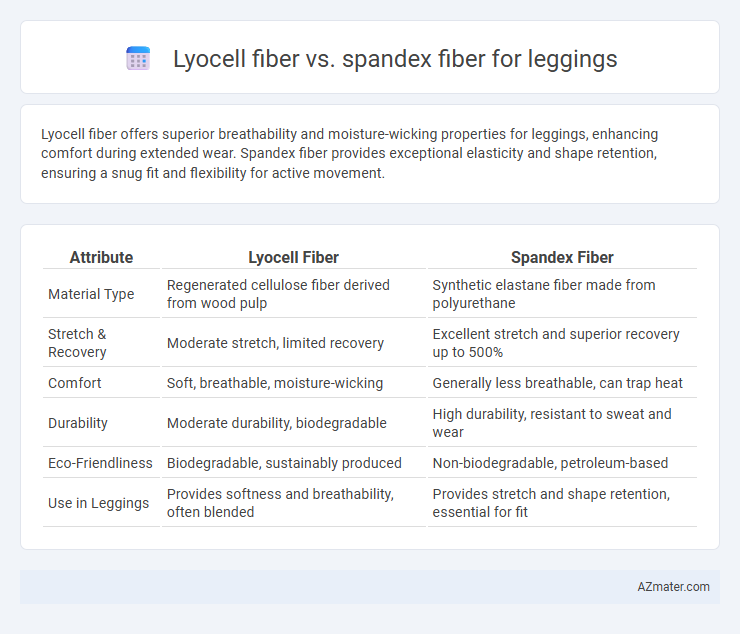Lyocell fiber offers superior breathability and moisture-wicking properties for leggings, enhancing comfort during extended wear. Spandex fiber provides exceptional elasticity and shape retention, ensuring a snug fit and flexibility for active movement.
Table of Comparison
| Attribute | Lyocell Fiber | Spandex Fiber |
|---|---|---|
| Material Type | Regenerated cellulose fiber derived from wood pulp | Synthetic elastane fiber made from polyurethane |
| Stretch & Recovery | Moderate stretch, limited recovery | Excellent stretch and superior recovery up to 500% |
| Comfort | Soft, breathable, moisture-wicking | Generally less breathable, can trap heat |
| Durability | Moderate durability, biodegradable | High durability, resistant to sweat and wear |
| Eco-Friendliness | Biodegradable, sustainably produced | Non-biodegradable, petroleum-based |
| Use in Leggings | Provides softness and breathability, often blended | Provides stretch and shape retention, essential for fit |
Introduction to Lyocell and Spandex Fibers
Lyocell fiber is a sustainable, biodegradable fabric made from wood pulp, prized for its softness, breathability, and moisture-wicking properties, making it ideal for comfortable leggings. Spandex fiber, composed of polyurethane, offers exceptional elasticity and shape retention, providing leggings with superior stretch and flexibility for activewear. Combining Lyocell's natural comfort with Spandex's flexibility creates leggings that are both eco-friendly and performance-driven.
Fiber Origins and Manufacturing Processes
Lyocell fiber originates from sustainably harvested eucalyptus wood pulp, processed through a closed-loop solvent spinning method that minimizes environmental impact and produces a soft, breathable fabric ideal for leggings. Spandex fiber, derived from petroleum-based chemicals, is synthesized via a complex polymerization process involving polyurethane, resulting in a highly elastic material that provides superior stretch and shape retention. The eco-friendly production of Lyocell contrasts with the chemical-intensive manufacturing of Spandex, influencing legging durability, comfort, and sustainability.
Key Properties: Lyocell vs Spandex
Lyocell fiber offers exceptional breathability, moisture-wicking capabilities, and a sustainable production process, making it ideal for comfortable, eco-friendly leggings. Spandex fiber is known for its superior elasticity, shape retention, and stretchability, providing leggings with excellent flexibility and a snug fit. Combining Lyocell with Spandex results in leggings that balance softness, durability, and stretch performance for activewear and everyday comfort.
Comfort and Breathability in Leggings
Lyocell fiber offers superior breathability and moisture-wicking properties, making leggings comfortable for extended wear by keeping the skin dry and cool. Spandex fiber provides exceptional stretch and shape retention, enhancing legging fit but can trap heat and reduce airflow compared to Lyocell. Combining Lyocell's natural breathability with Spandex's elasticity can deliver leggings that balance comfort and performance effectively.
Stretch and Elasticity Performance
Lyocell fiber offers moderate stretch with excellent moisture-wicking and breathability, making it comfortable for everyday legging wear. Spandex fiber provides superior elasticity and recovery, enabling leggings to stretch significantly and retain shape without sagging. Combining Lyocell with Spandex enhances both comfort and high-performance stretch, ideal for activewear demanding flexibility and durability.
Moisture Management Capabilities
Lyocell fiber offers superior moisture management for leggings due to its high absorbency and excellent breathability, enabling quick moisture wicking and enhanced comfort during physical activities. In contrast, spandex fiber provides minimal moisture absorption but excels in stretch and shape retention, often requiring blending with more absorbent fibers for effective moisture control. Combining Lyocell with spandex optimizes leggings by balancing moisture-wicking properties with flexibility and durability.
Durability and Longevity Comparison
Lyocell fiber offers superior durability in leggings due to its natural cellulose structure, providing excellent resistance to wear and tear during extended use. Spandex fiber, while highly stretchable and flexible, tends to degrade faster under frequent stretching and washing, impacting the longevity of leggings containing higher Spandex content. Combining Lyocell with a moderate amount of Spandex enhances overall garment longevity by balancing durability with elasticity for long-lasting performance.
Sustainability and Environmental Impact
Lyocell fiber, derived from sustainably managed eucalyptus wood through a closed-loop process, offers superior biodegradability and low environmental impact compared to Spandex fiber, which is petroleum-based and non-biodegradable. Lyocell production uses less water and fewer chemicals, reducing pollution and resource depletion, whereas Spandex manufacturing consumes high energy and releases toxic emissions. Choosing Lyocell blends in leggings supports eco-friendly fashion by promoting renewable materials and minimizing carbon footprint.
Care and Maintenance Guidelines
Lyocell fiber leggings require gentle washing with cold water and mild detergent to maintain their softness and prevent fiber damage, and should be air-dried away from direct sunlight to avoid weakening the fabric. Spandex fiber leggings demand careful handling to preserve elasticity; washing in cold water with a gentle cycle and avoiding fabric softeners or bleach prolongs their stretch and fit. Both fabrics benefit from avoiding high heat drying, with Lyocell needing extra care due to its natural cellulose base, whereas Spandex's synthetic nature resists wrinkling and shrinking but remains sensitive to heat exposure.
Choosing the Best Fiber for Leggings
Lyocell fiber offers excellent breathability, moisture-wicking properties, and eco-friendly benefits, making it ideal for leggings designed for comfort and sustainability. Spandex fiber provides superior stretch, shape retention, and flexibility, essential for performance leggings requiring maximum mobility. Choosing the best fiber depends on prioritizing either natural comfort and environmental impact (Lyocell) or high elasticity and durability (Spandex) based on specific activewear needs.

Infographic: Lyocell fiber vs Spandex fiber for Legging
 azmater.com
azmater.com